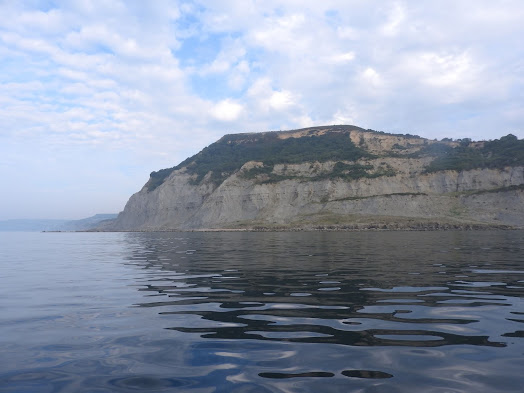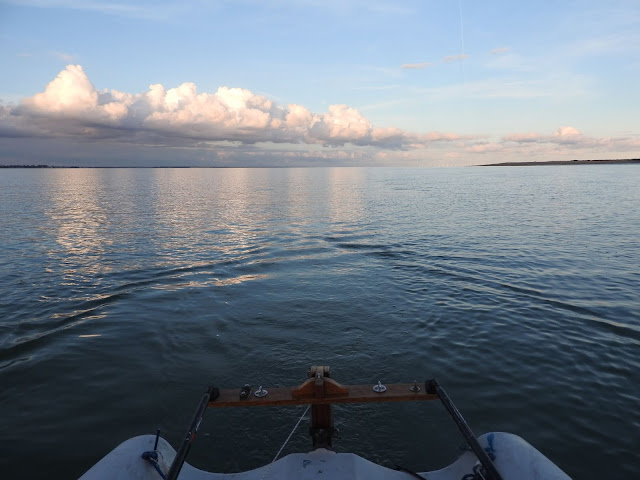Before the lockdowns, the second journey along the Heart of the Jurassic Coast took me past some iconic coastline, not least the Golden Cap.
The blog records the voyages of PicoMicroYacht, a seaworthy small sailing dinghy converted for rowing long distances. This includes the 26th July 2012 crossing of the English Channel, as well as rowing along the south coast of England, down the river Thames, around London and across Ireland. PicoMicroYacht is a converted Laser Pico Sailing Dinghy, with a sliding seat, riggers and cleaver oars, fitted with a shortened main mast and a mizzen mast and can be set up as a reduced rig sailing boat.
Other PicoMicroYacht
Monday, 21 December 2020
The Heart of the Jurassic Coast: Bridport to Lyme Regis
Sunday, 29 November 2020
The Heart of the Jurassic Coast: Abbotsbury to Bridport
In the summer I decided to voyage further along the Jurassic coast from Abbotsbury to Lyme Regis. Here the spectacular coastline is part of the older Jurassic landscape, the strata laid down between 200 and 164 million years ago in shallow seas, trapping a myriad of fossils, exposed as the cliffs crumble into the sea.
My first port of call was Bridport.
Abbotsbury is at the end of Chesil Beach that stretches east to Portland, this beach an extensive shingle bank.
My first task was to haul PicoMicroYacht up and over the shingle. Having done so I walked back down and inspected the track I had made.
I looked up and saw holiday caravans perched on the cliffs.
Bridport is not ideal for yachts because of the exposed entrance, but has been improved substantially. In past times the narrow channel was notoriously dangerous to shipping in any sort of sea.
Maurice Budden's photograph of the old Bridport entrance
https://www.geograph.org.uk/photo/3180105
Saturday, 7 November 2020
Crossing the Bar at Salcombe
The film clips in this post are provided if it is viewed in the Web version.
Saturday, 10 October 2020
The PicoMicroYacht Music Box
I really like being out at sea and listening to music, preferably with the volume up. The sea is one place you can listen to music surrounded by nature without tending to bother other people. To keep my music systems safe, I have put them in a waterproof box. This video shows the system I use (the video appears only if viewing on the web version).
Tuesday, 1 September 2020
Just the Sea and the Sky
Earlier this year, I left Bradwell on Sea, at the mouth of the Blackwater Estuary, to go to the River Colne entrance. But it was getting cold and dark and I returned early. Yesterday, I had another go.
By starting 3.5 hours after Dover High Tide, I knew I would have about 2.5 hours of fair tide to row the 7.5 miles. I could then return with a reversed flooding tide.
The flatlands of Essex made the sky more prominent and very quickly I felt enveloped between the sea and the sky.
Powered by a light easterly wind, a superyacht ghosted past me.
PicoMicoYacht arrived at the River Colne entrance on time, at 5.00 pm.
I then paused, drifting very slowly, with a slack tide and very little wind. It took ten minutes to make a quick meal using my Jetboil.
It was time to return. The setting sun lit up the clouds in the distance as I closed in on Bradwell on Sea.
I arrived just after 7.30 pm, the sun appearing over the marshes.
Monday, 10 August 2020
Visiting the Medway Queen
PicoMicroYacht recently visited the Medway Queen at Gillingham in the
Medway Estuary.
The Medway Queen moored in Gillingham
This is of the of the most iconic British paddle steamers to
be built in the 20th Century. At the bottom of this post is a short
video of her involvement in the second world war and also the link with my
great Uncle Commander Kenneth Greig.
The Medway Queen launched in 1924 and used as passenger
ferry when in 1940 it was commandeered for minesweeping operation as part of a
flotilla working off Dover. That year it also helped out with the evacuation of
British and French troops from Dunkirk. After the war it returned to being a ferry until 1963, and ended up being used for a night club at the Island marina on the Isle of
wight, being then rescued from a dilapidated state and now returned to the Medway estuary.
I feel connected to this boat because my Great Uncle,
Commander Kenneth Greig was in charge of the Dover mine sweeping flotilla that
that included the Medway Queen. He directed operations from a large paddle steamer,
the Sandown, an Isle of White passenger ferry. The flotilla consisted of these
two boats, together with PS Brighton Belle and PS Gracie Fields.
The Sandown, commanded by Kenneth Greig
My uncle took considerable risk clearing the Dover straight of mines at a time when German Luftwaffe flew the short distance across the English Channel to dive bomb the British shipping as they passed through. He was comforted by Sandown’s lucky mascot, a dachshund dog called ‘Bombproof Bella’.
The Luftwaffe dive bombing British ships off Dover in 1940
On the Tuesday 28th May 1940, the situation in
Dunkirk was desperate and the flotilla was diverted to sail there to evacuate
troop. The Sandown was the first to reach Dunkirk and too about 200 troops. The
Brighton Belle was sunk by a mine, the Medway Queen on hand to pick up the 800
or so men as she slowly sank. The next day, Gracie Fields was sunk by the Luftwaffe (not by a mine as indicated in my video below) with
differing accounts, either that she sank slowly, her rudder damaged or that
took a direct hit and went down quickly.
The Medway Queen at war
The two ships left kept going. On 31st May the Sandown rescued a boat with 250 troops, stranded on the Goodwin Sands. It then went off to Bray, east of Dunkirk and was under shelling from Nieuwpoort and with air attacks, which caused it to move position to throw off the range. Two parachuted magnetic mines were dropped close to her. Eventually, by midnight she moved off with 900 British troops.
A trip was made by the Medway Queen on Sunday 2nd
June. This trip was in the late evening and with their commander and crew exhausted, such that Commander
Greig went aboard and offered to take over to relieve the officers for the
night.
Initially this was flatly refused but a compromise was reached in which Commander Greig’s party would take the ship across the channel and then return the command for her to be taken in. She arrived alongside a Mole at 1.30 am and took 723 French soldiers off by ladder, being shelled continuously, but to no effect.
Troops loading from the Mole
After this on the following day the Medway Queen made her 7th and final trip, receiving French soldiers. As the troops embarked a shell hit a ship astern which then crashed into the Medway Queen damaging her starboard paddle box. She limped home, the end of her finest hour.
Just after Dunkirk, the commander of the Medway Queen was awarded the DSC and
Commander Greig the DSO.
Further details about the Medway Queen can be found on the Preservation Trust website: https://www.medwayqueen.co.uk/
Sunday, 14 June 2020
Rye at low water and meeting the people from the RNLI
I got out of PicoMicroYacht and towed it forwards, stepping carefully over a mixture of mud and shingle until I reached the slipway. On arrival PicoMicroYacht was at a critical 0.6 metres below the slipway and stuck in the mud.
Thursday, 4 June 2020
Dungeness
When I arrived at Rye it was low tide and a further challenge was to get in the harbour, the subject of my next post.
Tuesday, 19 May 2020
PicoMicroYacht's first voyage
The UK Government had published guidelines about recreational water sports as follows:
The Government also allowed for travel to get to the relevant places for such sports.
In addition, my own rules were:
(1) Not going in the club house at all
(2) Using disposable gloves when I unlocked the gate to enter the club and gain access to the slipway.
(3) Not to touch anything other than PicoMicroYacht (I broke this rule when I rescued a good piece of wood from a bonfire).
I brought with me all food and drink and left nothing.
When I arrived, I chatted briefly with two other sailors, keeping a good distance. They seemed happy to be able to visit the club and do some work on their boats.
As I headed out, I realised the harbour entrance was being patrolled by the harbour master, presumably checking that people were following the regulations.
I moored up and napped for a while, and then headed up the harbour, the wind strengthening all the time.
It was not long before I reached the channel that runs north of Hayling island.
The first main feature was the dilapidated railway bridge, originally built in 1864.
As I got closer, the waves started to pile up and I had to be quite careful to aim though the gap, passing the large structure that supported the rotating bridge.
The water quickly calmed and I next passed under the road bridge, with six inches to spare for my mast.
It was nearly high tide and as the sun started to set as I turned south towards the Chichester Harbour Entrance, back to my sailing club.
Including some detours, the total distance had been 19 miles, a pleasant and memorable voyage.




























































